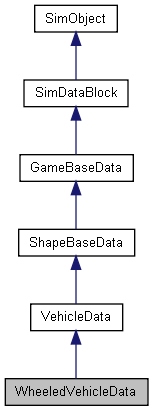

|
|
|
Defines the properties of a WheeledVehicle. More...

Public Attributes | |
| float | brakeTorque |
| Torque applied when braking. | |
| float | engineBrake |
| Braking torque applied by the engine when the throttle and brake are both 0. | |
| SFXTrack | engineSound |
| Looping engine sound. | |
| float | engineTorque |
| Torque available from the engine at 100% throttle. | |
| SFXTrack | jetSound |
| Looping sound played when the vehicle is jetting. | |
| float | maxWheelSpeed |
| Maximum linear velocity of each wheel. | |
| SFXTrack | squealSound |
| Looping sound played while any of the wheels is slipping. | |
| ParticleEmitterData | tireEmitter |
| ParticleEmitterData datablock used to generate particles from each wheel when the vehicle is moving and the wheel is in contact with the ground. | |
| SFXTrack | WheelImpactSound |
| Sound played when the wheels impact the ground. | |
Defines the properties of a WheeledVehicle.
The model used for the WheeledVehicle has a number of requirements:
Torque applied when braking.
This controls how fast the vehicle will stop when the brakes are applied.
Braking torque applied by the engine when the throttle and brake are both 0.
This controls how quickly the vehicle will coast to a stop.
Looping engine sound.
The pitch is dynamically adjusted based on the current engine RPM
Torque available from the engine at 100% throttle.
This controls vehicle acceleration. ie. how fast it will reach maximum speed.
Looping sound played when the vehicle is jetting.
Maximum linear velocity of each wheel.
This caps the maximum speed of the vehicle.
Looping sound played while any of the wheels is slipping.
The volume is dynamically adjusted based on how much the wheels are slipping.
ParticleEmitterData datablock used to generate particles from each wheel when the vehicle is moving and the wheel is in contact with the ground.
Sound played when the wheels impact the ground.
Currently unused.